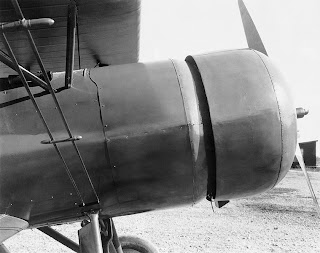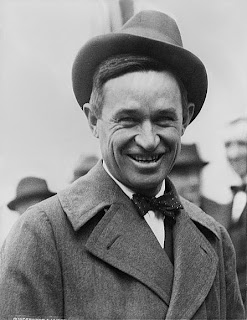The Lockheed Vega
Designed by John K. Northrop, the Lockheed Vega was the first aircraft with the NACA cowl, which streamlined the airflow around and through the engine. This decreased drag and increased power plant cooling. With decreased drag the speed increased. The cowl also used the heat of the engine for added thrust. This cowl decreased drag as much as 60%. The NACA cowl also directed air across the engines hottest parts..the cylinders and cylinder heads. The streamlining reduced turbulence as compared to the air flowing over free standing radial engine cylinders. The Vega first flew in 1927. The plane's dimensions are as follows..
Wingspan: 12.5 m (41 ft)
Length: 8.4 m (27 ft 6 in)
Height: 2.5 m (8 ft 2 in)
Weight, empty: 1,177 kg (2,595 lb)
Weight, gross: 2,041 kg (4,500 lb)
Wiley Post
 |
| NACA Cowling shown on Curtiss Aircraft |
Born near Grand Saline Texas in 1898, Wiley Post was arrested in 1921 for car hijacking near Ninnekah Oklahoma.
The family had migrated to Oklahoma and jobs being tough to find Wiley decided to try his hand at highway banditry. Post was tried for his crimes and sentenced to 10 years imprisonment at Granite Oklahoma. After being paroled only one year later, Wiley Post went on to become a distinguished aircraft pioneer. The Wiley Post story is probably one of the best examples of someone turning their life around after some ill advised early adult decisions.
Wiley Post the Aviator
Wiley Post loved mechanics but hadn't seen a real airplane close up until the day he saw his first aircraft at the Lawton County Fair. Post's first job was in construction helping to build the Army airfield at Fort Sill Oklahoma. After that Post joined the Army and wanted to become a pilot but ended up being trained as a radio operator when World War One concluded.
It was 1919 and Post was back in Oklahoma working as a roughneck in the old fields. It was during this time he finally got his first airplane ride with a barnstormer. Jobs were scarce and after the oil field job Wiley unfortunately turned to crime. It was at this point he was arrested as mentioned above and sentenced to ten years imprisonment. Post was fortunate and served only 13 months before being paroled.
Now out of prison Wiley decided to earn an honest living and joined a flying circus as a parachute jumper. The job paid quite well. Post was earning between $100-$200 per jump and he reportedly made a total of 99 jumps. It was during his time with the flying circus that Wiley finally had the chance to learn to fly.
As a side note, you may also enjoy our Western Trips article and photos of the Beech 18 at the Western Antique Aeroplane and Automobile Museum.
 |
| Inverted Curtiss-Jenny Stamp |
The plane was a Canadian version of the Curtiss Jenny (shown right on U.S. postage stamp) and Post used it to barnstorm across Oklahoma and Texas. barnstorming during this era included often dangerous airplane stunts as well as setting up in a farmer's field and offering airplane rides to the public.
There was a good deal of competition
among barnstormers and not a lot of regulation. More and more daring stunts were attempted. As a result there were a good share of accidents. During his time of barnstorming Wiley got married and continued performing for another two years. During this period he received his official flight certificate (license) from the government which included a waiver for his one blind eye.
Wiley Post and His Lockheed Vega
Wiley landed a job as pilot with Oklahoman oilman F.C. Hall's Travel Air biplane. Tired of fling an open cockpit biplane Hall went ahead a purchased a Lockheed Vega. The Vega was the equivalent of today's business jet. The most advanced and fasted plane at the time. The plane was named 'Winnie Mae" after Hall's daughter but not long thereafter Hall had to give the aircraft back to Lockheed because of his financial losses during the early years of the Great Depression. Wiley lost his job with Hall but was able to work out a deal to acquire the Winnie Mae from both Hall and Lockheed. Post used the Winnie Mae for his later record setting adventures.
The story of Wiley Post, inventor and record-setter has really not received the publicity you would have expected since his death in 1935. During his relatively short career, Post received many commendations, set many records and made many other attempts at aviation records, some successful, some not. His presence in aviation was on a par with both Amelia Earhart and Charles Lindbergh.
 |
| Aviator Wiley Post |
Wiley Post went on to set two around the world flying records.
The first flight around the world in June 1931 totaled 8 days, 16 hours with navigator Harold Gatty and the second in July 1933 took 7 days, 19 hours flying solo.
After his first record setting flight with Gatty, New York welcomed them home with a spectacular ticker tape parade. In addition to this Post developed along with the B.F. Goodrich Company a "pressure suit" which allowed him to fly the Winnie Mae into the stratosphere. Although the first pressure suit was reportedly developed in Russia in 1931, Wiley Post is credited with helping to develop one which was practical to use while flying an aircraft.
Post received financial support for his high altitude exploits from Oklahoma oilman Frank Phillips, founder of Phillips Petroleum. On September 5, 1934 Post flew with the pressure suit on to an altitude of 40,000 feet over Chicago. He later attained an altitude of 50,000 feet. Post's pressure suit not only enabled him to operate the aircraft controls but also to walk in and out of the aircraft.
 |
| Post in Pressure Suit |
Technology was advancing as so was aircraft design. Wiley Post's growing popularity put him in a position to build friendships with notables of the era such as Will Rogers and Amelia Earhart. The man who at one time resided in an Oklahoma prison went on to establish himself as one of America's prominent citizens and acquaintance of U.S. presidents.
.
In 1935, Will Rogers, friend of Oklahoman Wiley Post, bought a hybrid plane built from two wrecks. The fuselage was from a Lockheed Orion, the long wing from a Lockheed Explorer. Rogers called the plane Aurora Borealis. When the pontoons he had ordered did not arrive, he had a set installed that were designed for a much larger plane.
After several hunting and fishing stops in Alaska, Post and Rogers took off for Point Barrow. After getting lost in bad weather, Post landed in a lagoon near Point Barrow to ask for directions. When they tried to take off again the plane's engine died and the nose heavy plane dropped to earth killing both men.
 |
| Will Rogers |
The life and accomplishments of Wiley Post are truly spectacular. The story has not received the attention it warrants. There are several locations you might visit to learn more about this record breaking aviation pioneer.
One very good stop is the Science Museum Oklahoma in Oklahoma City Oklahoma. Several interesting Wiley Post artifacts can be found in their Oklahoma Aviation and Space Hall of Fame.
Another interesting stop is at The Oklahoma Museum of Flying at the Wiley Post Airport in Bethany Oklahoma.
On the west coast you may want to take a side trip to the Will Rogers-Wiley Post Memorial Seaplane Base in the northwest corner of the Renton Municipal Airport on Lake Washington in Renton Washington.
If your travels take you to the east coast, Wiley Post's "Winnie Mae" Lockheed Vega is on display at the Smithsonian National Air and Space Museum in Washington D.C. The Smithsonian also has on display the Vega owned by Amelia Earhart.
There's an interesting website regarding Charles Burrell Tibbs, the creator of the Burrell Tibbs Flying Circus of which Wiley Post once worked as a parachute jumper.
(Article copyright Western Trips. Photos and images from the public domain)

